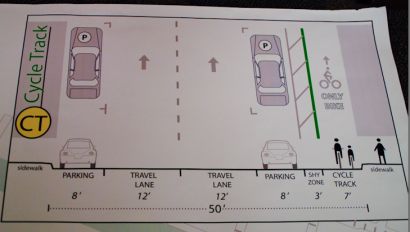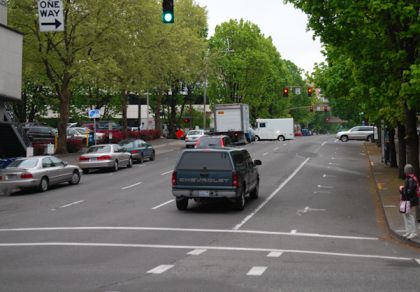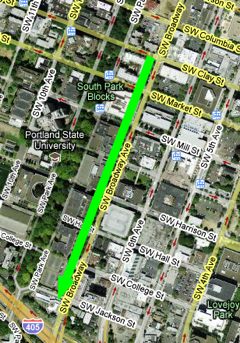
(Photos © J. Maus)
Speaking at a sustainability conference at Portland State University this morning, Portland Mayor Sam Adams announced a big shake-up in his plans to build the city’s first “high-profile” cycletrack.
“It will be shocking to a lot of Portlanders…and we hope it’s shockingly positive.”
— Mayor Adams, speaking about a new cycletrack on SW Broadway
Initial plans revealed last month had the cycletrack (which was one of his “First 100 Days” promises) going in at the North Park Blocks. But those plans are out because the Portland Fire Bureau said there wouldn’t be enough room for their trucks to operate on the street if it was narrowed for the new bikeway.
I spoke to Adams’ transportation policy director Catherine Ciarlo this morning and she said the Fire Bureau issue is “an intractable problem and we can’t work around it.” (In Europe, Ciarlo told me, fire trucks are much smaller).
But the problem seems more like a blessing in disguise. The new cycletrack — which both Ciarlo and Adams says has always been in the plans — will be much more high-profile (the Park Blocks cycletrack had a lot of detractors). Adams announced this morning that the new cycletrack will run on SW Broadway from Clay to SW Jackson — right through the heart of the Portland State University campus.
To complete the cycletrack, the city intends to remove one of the three existing motor vehicle lanes. The new road configuration will include a 7-foot bikeway, a 3-foot “shy zone” (so people can get out of their cars and open doors without impeding bike traffic), an 8-foot parking lane, and then two, 12-feet motor vehicle lanes.

When asked how they’ll deal with potential pushback about removing a motor vehicle lane from a major downtown street, Ciarlo said SW Broadway is “under capacity” in that area (which made the location “even more attractive” to them).
Ciarlo said their office feels that the capacity will actually increase once the cycletrack is installed. “It will change the number of lanes, but it won’t significantly effect the number of vehicles,” she said, “but it will increase the number of bikes…so it’s really a win-win.”
Ciarlo also added that they have done significant outreach to business owners and to PSU officials and that everyone is “excited” about the project.
In addition to this new cycletrack, PBOT also has new plans to install a “buffered bike lane”. The location of the new buffered bike lane — which will be installed in conjunction with this new cycletrack — is expected to be announced publicly next week.
The SW Broadway cycletrack is expected to be installed this summer and it will drastically alter the streetscape. Speaking with me before addressing the PSU sustainability conference this morning, Adams said he thinks the project “will be shocking to a lot of Portlanders…and we hope it’s shockingly positive.”
According to Adams, a high profile bikeway in this location will serve an “untapped capacity” which makes it a “great test case”.

Ciarlo, Adams’ transportation policy director, said the new facility will provide benefits not just for people who bike, but that it “will also provide a huge humanizing benefit for PSU students and pedestrians. The cycletrack will give the entire area a very different feel.”
- Cycletrack: Exclusive bicycle facility
adjacent to — but separated from —
the roadway by a physical barrier
(which in this case will be parked cars.)
- Buffered bike lane: Roadway
designated by buffered striping
and bicycle pavement markings
for the exclusive or preferential
use of bicycles.
Asked how the new facility will be paid for, Adams said, “We will identify a funding source in my proposed budget.” That statement would lead me to believe that Adams’ budget — which is set to be unveiled Friday evening — might include some sort of new, dedicated funding stream specifically for bike projects.
I don’t have specific budget estimates for this project (will have them soon), but Rob Burchfield, head traffic engineer for PBOT, said it will have only a “modest” cost. Like the bike boxes, this new roadway treatment will only consist of paint and signs and will therefore not be a very expensive. Burchfield estimates it will cost $47,000 (not counting outreach and marketing).
Also new this morning is an announcement that PBOT will work with the Institute for Bicycle and Pedestrian Innovation at PSU to conduct an evaluation study that compares the functionality and impact of the cycletrack versus the buffered bike lane.
Stay tuned for further developments.
You can learn all about PBOT’s plans for cycletracks, buffered bike lanes, and much more at the upcoming Bicycle and Streetcar Master Plan Update Open Houses. Check out when and where they’re happening in your neighborhood.

